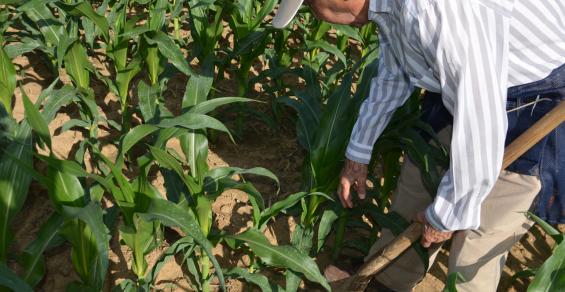Corn Illustrated: The answer likely lies below the surface.
Do you want to reduce the number of plants that lag behind their neighbors in your cornfield next year? Dave Nanda says the easiest way to do so is to walk fields this year. Find situations where stands are not uniform and put your shovel to work. Determine why plants aren’t the same size. Then make adjustments that should help reduce the number of plants that vary in size next season.
“I carry a shovel and dig up a plant here and there to answer questions,” explains Nanda, director of genetics for Seed Genetics Direct. “If you dig plants that aren’t the same size or don’t appear healthy, then dig healthy plants too. You should be able to make comparisons and determine what caused the difference.”
Nanda found a plant in one row in the Corn Watch ’22 field that was shorter than its neighbors. When he determined stage of growth, it was about one stage behind. Why was the plant out of sync with other plants in the field?
“It could have emerged later for some reason,” Nanda says. “We flag plants to monitor uniformity of emergence in 1/1,000-acre sections of several rows, but you can’t flag every row.
“There are other possibilities. There was rain after planting, and perhaps crusting or soil compaction affected this plant more than others. Digging will give you an idea of whether the soil is compacted, and you will get to see how roots developed.”
When Nanda dug this plant, he didn’t notice hard layers within the top few inches of soil. The roots tended to fan out and point downward, like roots should. When soils are very compacted, roots run horizontally instead of growing vertically since soil is harder to penetrate. In this case, Nanda suspected something else was going on besides soil compaction to cause a possible difference in plant growth.
He found his answer when he examined the seed, still visible at the depth it was planted within the roots.
“Instead of being bright, it was an off-yellow color,” Nanda says. “When I felt the seed, it was squishy instead of being firm. I concluded that it was quite likely that this seedling was affected by seedling disease that invades the seed. Germination and emergence occurred, but they may have been hampered by disease impacting the seed. That could help explain why this plant was smaller than its neighbors.”
SEED HOLDS CLUE: Dave Nanda examined the seed closely and found that it was discolored and mushy. The seedling was likely hampered by disease that attacked while the seed was launching the plant.
Once a plant gets a slow start, it’s likely to remain behind during the entire season, Nanda says. Such a plant may put on a smaller ear. If stressed or if two or more full growth stages behind, the plant may not produce an ear at all, or only a nubbin.
“That’s why uniform plant emergence is important,” he concludes.




